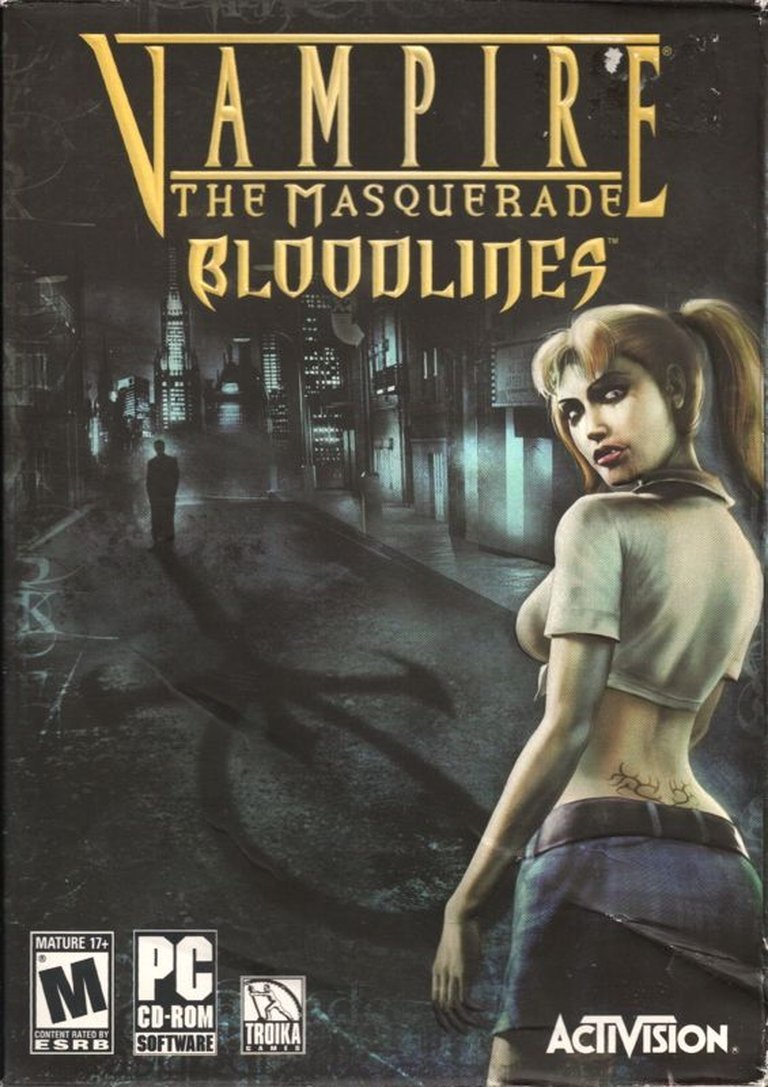- Release Year: 2004
- Platforms: Windows
- Publisher: Activision Publishing, Inc., ak tronic Software & Services GmbH
- Developer: Troika Games L.L.C.
- Genre: Role-playing, RPG
- Perspective: 1st-person, Behind view
- Game Mode: Single-player
- Gameplay: Action RPG, Base building, Character development, Crafting, Diplomacy, House ownership, Intimidation, Moral choices, Multiple endings, Open World, Shooter, Skill distribution, Stealth, Turn-based combat
- Setting: City, Contemporary, Fantasy, Haunted house, Hotel, North America
- Average Score: 90/100
- Adult Content: Yes

Description
Vampire: The Masquerade – Bloodlines is a critically acclaimed action RPG set in modern-day Los Angeles, where players take on the role of a newly turned vampire navigating a treacherous world of political intrigue, supernatural factions, and moral dilemmas. Based on the pen-and-paper RPG, the game offers deep character customization, multiple playstyles, and branching storylines that lead to one of five possible endings.
Gameplay Videos
Where to Buy Vampire: The Masquerade – Bloodlines
Vampire: The Masquerade – Bloodlines Free Download
Cracks & Fixes
Patches & Updates
Mods
Guides & Walkthroughs
Reviews & Reception
metacritic.com (80/100): The use of the Source engine gave Troika the ability to use their talents on fleshing out the incredible storyline and remarkable atmosphere.
imdb.com (100/100): This is, without a doubt, one of the best games I have ever played.
ign.com : A grand RPG, but a flawed gem of a game.
Vampire: The Masquerade – Bloodlines: Review
Introduction
Vampire: The Masquerade – Bloodlines is a landmark title in the annals of video game history, a game that dared to blend the rich lore of the World of Darkness with the immersive, player-driven narrative of a first-person RPG. Released in 2004, it was a bold experiment that, despite its technical flaws, has since achieved cult status among gamers and critics alike. This review aims to dissect the game’s legacy, exploring its development history, narrative depth, gameplay mechanics, and enduring influence on the RPG genre.
Development History & Context
Vampire: The Masquerade – Bloodlines was developed by Troika Games, a studio founded by former members of the team behind Fallout, including Leonard Boyarsky and Tim Cain. The game was built using the Source engine, which was also used for Half-Life 2, but Troika’s implementation faced significant challenges. The studio aimed to create a game that was true to the World of Darkness pen-and-paper RPG, offering deep role-playing mechanics and a richly detailed world.
The development process was fraught with difficulties, including a rushed release schedule and a lack of support from publisher Activision. The game was completed just in time for its November 2004 release, but it was plagued by bugs and performance issues. Despite these problems, the game’s core design and narrative depth shone through, earning it a dedicated following.
Narrative & Thematic Deep Dive
The game’s narrative is set in a dark, gritty version of Los Angeles, where vampires, werewolves, and other supernatural beings coexist in secret. The player takes on the role of a newly sired vampire, navigating the treacherous politics of the Camarilla, the Anarchs, and other factions. The story is nonlinear, with multiple endings that depend on the player’s choices and alliances.
The game’s themes explore the duality of human nature, the struggle between morality and monstrosity, and the consequences of power. The dialogue is sharp and often darkly humorous, with memorable characters like the enigmatic Jeanette and the charismatic Prince LaCroix. The game’s writing is a standout feature, offering a rich tapestry of intrigue, horror, and existential dread.
Gameplay Mechanics & Systems
Vampire: The Masquerade – Bloodlines offers a unique blend of first-person shooter and RPG mechanics. Players can choose from seven different vampire clans, each with unique abilities and playstyles. The game features a deep skill system, allowing players to specialize in combat, stealth, hacking, or social skills.
Combat is a mix of melee, ranged, and supernatural abilities, with a focus on strategy and resource management. Players must manage their blood points, which are used to activate vampire disciplines. The game also features a humanity system, which tracks the player’s moral choices and affects their susceptibility to frenzy.
The game’s user interface is functional but dated, with a notebook system that tracks quests and information. The loading times were notoriously long, and the game suffered from numerous bugs, many of which were addressed by fan-made patches.
World-Building, Art & Sound
The game’s world is a dark, atmospheric reflection of Los Angeles, filled with neon-lit streets, seedy bars, and hidden vampire havens. The art direction is a mix of gothic horror and cyberpunk, creating a unique visual style. The character models and facial animations are particularly impressive, adding depth to the game’s dialogue scenes.
The soundtrack is a blend of original compositions and licensed tracks, enhancing the game’s moody atmosphere. The sound design is excellent, with ambient sounds that immerse the player in the game’s world.
Reception & Legacy
Upon its release, Vampire: The Masquerade – Bloodlines received mixed reviews due to its technical issues. However, it has since been re-evaluated as a classic, praised for its narrative depth, character development, and innovative gameplay. The game’s influence can be seen in later titles like Deus Ex: Human Revolution and The Witcher 3, which also emphasize player choice and immersive storytelling.
The game’s legacy is further cemented by its dedicated fan community, which has created numerous mods and patches to address its issues. The announcement of Vampire: The Masquerade – Bloodlines 2 in 2025 has reignited interest in the original game, ensuring its place in gaming history.
Conclusion
Vampire: The Masquerade – Bloodlines is a flawed but brilliant game, a testament to the power of narrative and player choice in video games. Despite its technical issues, it remains a landmark title that has inspired countless games and gamers. Its legacy is secure, and its influence continues to be felt in the RPG genre. For those willing to look past its bugs and performance issues, Bloodlines offers an unforgettable journey into the dark heart of the World of Darkness.